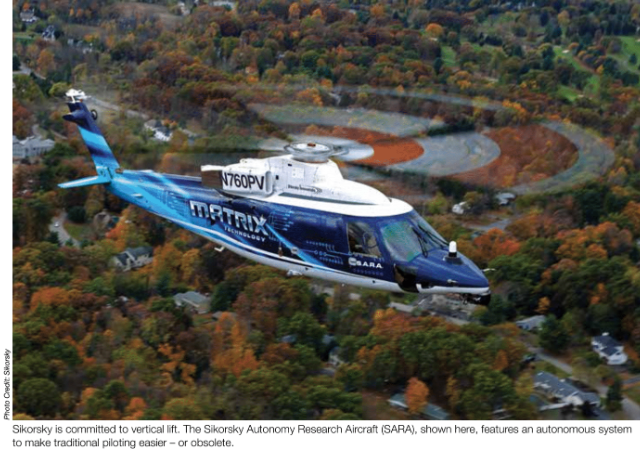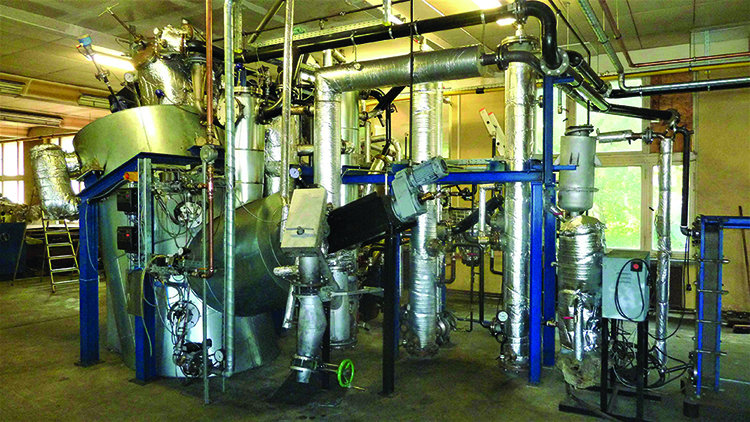

On the Cusp of a Transportation Transformation
Imagine hopping in an electric air taxi on a heliport atop your New York office and traveling 14 miles away to John F. Kennedy International Airport in just six minutes to catch a flight to Philadelphia for a meeting. Or, even better, skipping the commercial flight altogether and taking a 27-minute air taxi directly to your Philadelphia destination. That’s the goal of Lilium, an aviation company based in Munich.
Founded in 2015, Lilium has designed and prototyped the Lilium Jet, a five-seat, electric vertical take-off and landing (eVOTL) aircraft the company hopes will be fully operational in cities worldwide by 2025. Lilium is just one of dozens of companies working on aircraft for the budding urban air mobility (UAM) movement, from large OEMs like Boeing to small entrepreneurships and divisions of ride-hailing companies such as Uber Elevate.
“Urban air mobility is the use of low-altitude air space in, around and between cities for the movement of people and goods,” says Jonathan Hartman, disruptive technology lead with Sikorsky Innovations, part of Lockheed Martin. “It’s about adding a new dimension to the existing multimodal mobility networks that we already have.”
Urban air mobility may still seem like fodder for futuristic sci-fi movies, but it’s very much a tangible business in the here-and-now. As of September 2018, more than $1 billion had been invested in UAM, according to an urban air mobility market study conducted for NASA by the information technology consulting firm Booz Allen Hamilton.
“UAM will take the aviation industry and make it accessible to private citizens on a daily basis,” says Andrea Shestopalov, unmanned traffic management program manager for AiRXOS, part of GE Aviation. “The time is now for people to start getting in the game because there’s a tremendous opportunity to provide value.”
That opportunity extends to composites suppliers and manufacturers. “To make a vehicle that’s sustainable and feasible in this space, it’s going to have to be very light and very strong,” says Shestopalov. “And that’s where the composites industry can come in and be the only game in town.”

Opportunities for UAM
The concept behind urban air mobility isn’t new. “It’s a new term for a mission that has been executed for the last four or five decades by companies, including Sikorsky,” says Hartman. “Helicopters serve this mission today.” Traditional rotor-blade helicopters have been used in cities for functions such as critical care medical transport and media reporting on traffic, but they haven’t transformed into a ubiquitous mode of transport. Experts agree that’s poised to change, thanks to two key enabling technologies.
“People wonder why this time is different than all the others when they were promised flying cars,” says Ken Goodrich, NASA’s advanced air mobility deputy project manager for technology. “The real difference is advancements in automation and autonomy technology to simplify operation of the vehicles combined with electric propulsion, which helps dramatically reduce operation and maintenance costs, along with increasing community compatibility.”
eVOTL aircraft offer opportunities to improve urban congestion, enhance mobility, decrease transport time for people and goods, reduce pollution and decrease the strain on existing public transportation networks. These aims are all critical as the worldwide population continues to grow and migrate to urban and suburban areas.
“The United Nations (U.N.) says that millions of people per week are moving from rural areas to suburban and urban areas, and that’s a trend that’s going to continue for the next decade,” says Hartman. “Imagine a city the size of New York popping up on the globe once every month to month-and-a-half for the next 10 years.”
The 2018 U.N. report on the world’s cities cited by Hartman also indicates that by 2030 there will be 43 megacities – those with more than 10 million people – compared to 33 megacities around the world in 2018. The cost to develop and maintain the necessary ground infrastructure will be tremendous. “It’s an untenable position, and we’ll see more and more congestion,” says Hartman. “Utilizing the air space – the third dimension of mobility – gives you the opportunity to add rapid transport back into cities.”
Challenges to Implementation
While UAM presents undeniable opportunities, there are numerous challenges, most of which relate to three main areas: the vehicles, infrastructure and public acceptance.
“We need to get the vehicle technology to the point where it is available, manufacturable and reliable,” says Jim Sherman, director for strategic development for the Vertical Flight Society, a technical society for engineers, scientists and others working to advance vertical flight technology. Currently, he says, most vehicles are one-offs or prototypes, with a handful of companies conducting flight testing.
In the United States, the vehicles also must be certified by the Federal Aviation Administration (FAA). Given the wide variance in designs, this could be arduous. “The FAA has started to address that through adoption of performance-based regulations as opposed to prescriptive-based ones,” says Sherman. “Utilizing performance-based regulations based on industry standards by organizations such as SAE International and ASTM International will enable broader operational requirements, rather than highly prescriptive regulations.”
Perhaps the biggest hurdle related to the vehicles themselves centers around cost. “Building these vehicles needs to be much more cost effective than light aircraft are today,” says Goodrich. The UAM market will demand thousands of aircraft produced annually. But there’s a commercial risk, suggests Burak Uzman, general manager of Coriolis Composites USA, a provider of robotic cells and software for automated composite additive manufacturing. “Is there a business case for people to buy, lease or operate them?” asks Uzman. “That is highly dependent on the price tag of the air vehicle, and a lot of that will be driven by the composite airframe.”
The second primary area of consideration is infrastructure – everything needed to make the journey seamless from the take-off location to the landing location. This includes heliports, streets, elevators, buildings and more. “We are talking about an unprecedented level of integration of all these systems, both fixed and mobile infrastructure, in a way that is completely opaque to the users, but guarantees safety, reliability and availability,” says Hartman.
Another key component related to infrastructure is air traffic management – particularly if the vehicles transition from piloted to unmanned aircraft. “You can’t just take the unmanned piece and add it as a separate component of the manned traffic system,” says Shestopalov. “The manned traffic system is a different beast, where everything is manual and done via radios and monitors. Unmanned traffic systems have digital traffic management tools that will have to be integrated in.”
The final challenge – gaining public acceptance – is equally important to the hurdles associated with the vehicles and infrastructure. The introduction of a new modality of transportation into cities presents a host of societal barriers related to safety, privacy, noise and more. “UAM is an inevitable wave,” says Shestopalov. “The question is how do we get people on board more quickly? A lot of that has to do with proving out the technology and showing things can work – having use cases that are low risk.”
Vehicles and Enabling Technologies
Many groups are focused on “showing things can work,” developing aircraft and technologies that will enable UAM. These include three highlighted here – a UAM startup, a traditional aerospace manufacturer and a large government agency.
Lilium’s four founders all attended the Technical University of Munich. When they launched the company with the mission to create a revolutionary urban air mobility solution, the co-founders evaluated more than 20 existing aircraft concepts, from multicopters to tilt rotor aircraft. None were quite what they were looking for, so the engineers designed an eVOTL with 36 engines mounted on its flaps.
The Lilium Jet features two fixed wings – one main wing at the rear and a canard wing at the front. The jet doesn’t have a tail, rudder, oil circuits, gearboxes or variable pitch fan blades. The only moving parts are the engines, which are distributed along the wings to distribute power and generate efficiencies. According to the company’s website, the simple design “makes the aircraft more robust, it makes it safer, it makes it easier to maintain and it lowers the cost to certify, manufacture and operate the aircraft.”
Last fall, Lilium completed its first phase of flight testing, flying at speeds exceeding 62 mph. Its goal is to reach up to 186 mph in one hour on a single charge. The company also built a 9,800-square-foot manufacturing plant for serial production of its eVOTL and is currently building a second facility.
Achieving these milestones takes funding, and Lilium has attracted numerous investors. In late March, the company obtained funding of more than $240 million, bringing the total sum raised in five years to more than $340 million. The newest investor, Chinese multinational conglomerate holding company Tencent, joins existing venture capitalist investors Atomico, Freigeist and LTM.
Sikorsky Innovations, founded in 2010 to advance vertical flight, builds on the long tradition of helicopter production at Sikorsky. “We do not have an active development project for a vehicle specifically at this moment, but we’ve been working on several key technologies,” says Hartman. These include electric propulsion, fleet management and autonomy.
Since 2013, Sikorsky has invested in a technology called MATRIX™, which combines hardware and software components to enable autonomous or optionally-piloted aircraft. “MATRIX allows us to reduce the workload on the pilot, turning stick-and-rudder controls into touch-and-go pilot interfaces,” says Hartman. “As we continue to mature and deploy the technology, urban air mobility is certainly one of those applications under consideration.”
NASA also has several projects related to UAM, although the agency has begun pivoting to the term AAM – Advanced Air Mobility. “AAM reflects that the basic technologies surrounding UAM can enable a whole range of new missions and new cases not restricted to urban areas,” says Goodrich. Goods and people could be transported locally, regionally or interregionally.
NASA’s research and development in AAM is comprehensive. “It cuts across most of the aeronautics areas that NASA has historically worked in,” says Goodrich. “The only things outside the scope of AAM are supersonic and hypersonic flight.”
The agency has identified five pillars of technology that must be addressed to move AAM forward: basic aircraft design, piloting, design of an overall airspace architecture, real-time operation in that airspace and community integration. Goodrich says NASA has active projects in all five areas.
Earlier this year, NASA launched the Advanced Air Mobility National Campaign (formerly the UAM Grand Challenge) to promote public confidence and accelerate the AAM movement. In March, the agency signed agreements with 17 companies in the aviation industry to participate in developmental flight testing, airspace simulation and vehicle provider information exchange.
The Role of Composites
The complexity of the UAM movement will require innovative composite solutions. “It’s a paradigm shift with a lot of unknowns, and in the face of unknowns we hunt down the highest-tech, best option available on the market,” says Uzman of Coriolis Composites USA. “Every pound that we save on the aircraft structure is crucial to making the platform a success.” Less weight in the aircraft allows for more weight in the battery, which will allow the vehicle to fly longer and farther.
Coriolis Composites has teamed with several companies building UAM vehicles and installed AFP machines at their facilities. Traditionally, the equipment has been used to manufacture components for large, wide-bodied commercial airlines. By contrast, UAM vehicles are much smaller and require complicated features. This is where Coriolis AFP equipment “shines,” says Uzman.
“For the number of tows placed, our equipment head has the smallest form factor. So it can get into very tight spaces and lay up very complicated parts,” he says. “With the additive manufacturing process, you can do lots of things with fiber placement through automation that you can’t do through manual layup.” Coriolis Composites’ customers are primarily using carbon fiber prepregs with epoxy resins, though some are looking into thermoplastic composites.
The company is also focused on automated inspection and verification of parts for the UAM market. “The market segment is talking about thousands of aircraft a year, so manual inspection isn’t an option. It has to be automated,” says Uzman. At least two companies plan to roll out Coriolis Composites’ automated inspection and verification solutions at their plants this year.
“It remains to be seen how they will qualify these systems and get the FAA to agree that this is an adequate inspection process or if human-in-the-loop inspection is required,” says Uzman. “It’s uncharted territory.”
Advice for Composites Companies

The question of when UAM will become a reality is a tricky one, dependent largely on what’s considered a milestone. (For example, drone delivery of packages compared to full air taxi service.) Sherman of the Vertical Flight Society speculates that if flight demonstrations occur this year, then UAM could be operational by 2023. Shestopalov with AiRXOS believes flights over water – for instance, taking off at San Francisco International Airport and landing on a heliport near your destination in the San Francisco Bay – could happen within the next five years. But she says the real shift, “providing a flight somewhere that costs what an UberX costs now,” is at least 10 years out.
There are several steps composites companies can take to help propel the UAM movement forward, including these four:
Form partnerships with unexpected companies. Last year, Sikorsky collaborated with Otis Elevators, which invented the first safety elevator and moves billions of people daily. UAM has the ability to connect destinations the same way that an elevator first connected floors together, allowing for skyscrapers and today’s modern cities, says Hartman. “When was the last time you heard about an aerospace company talking to an elevator company?” he says. “Those are the types of non-traditional relationships we are going to need to make this work.”

Serve as advisors to OEMs. As the market matures, it will require 10,000 to 20,000 vehicles a year, says Sherman. “Bell, Boeing, Airbus and other OEMs can’t produce aircraft at that rate, so they will need some education and assistance from composites companies that can produce at automotive rates,” he says.
Focus on the big picture, not just the aircraft. Sikorsky is a founding member of the World Economic Forum’s UAM Working Group that brings together industry, policy makers, academia and public sector leaders to develop a global plan for UAM. “We need to start thinking about UAM from a holistic level down as we are also doing bottoms-up building of air vehicles,” says Hartman. “As an industry, we are committed to and excited about designing new things, but we have to take a moment and ask about all the requirements those new things are going to fall under.”
Continue pushing the performance of composites. “I would surmise that a lot of the applications we are talking about are really going to push the envelope on composite performance,” says Hartman. “We’re going to ask composites to do things they haven’t done before and operate in ways they haven’t before.” For instance, some companies are considering structural batteries that integrate composites with battery materials so the battery serves as both an energy storage device and a structural component.
These are exciting times for an industry like composites that thrives on innovation. “Over the next 30 years, there’s a transformational opportunity to introduce new multimodal mobility,” says Hartman. “We’re going to have to look beyond spec sheets and catalogs and work collaboratively as an entire supply chain and technology base to go forward.” And to go up into the third dimension.

SUBSCRIBE TO CM MAGAZINE
Composites Manufacturing Magazine is the official publication of the American Composites Manufacturers Association. Subscribe to get a free annual subscription to Composites Manufacturing Magazine and receive composites industry insights you can’t get anywhere else.





